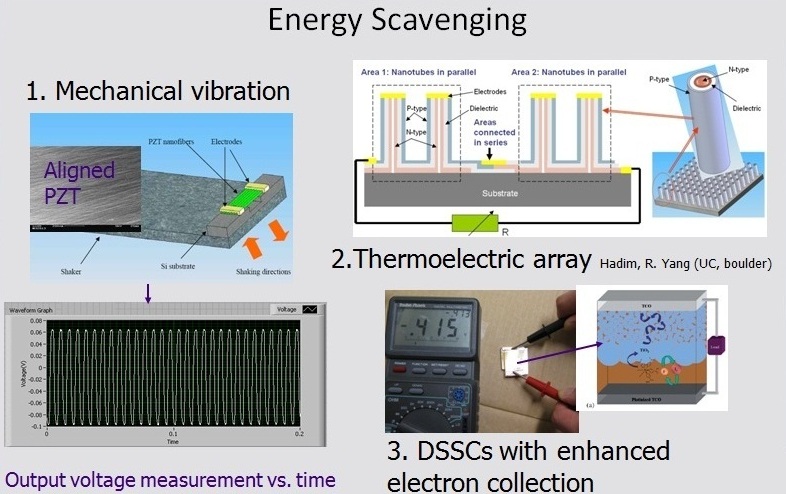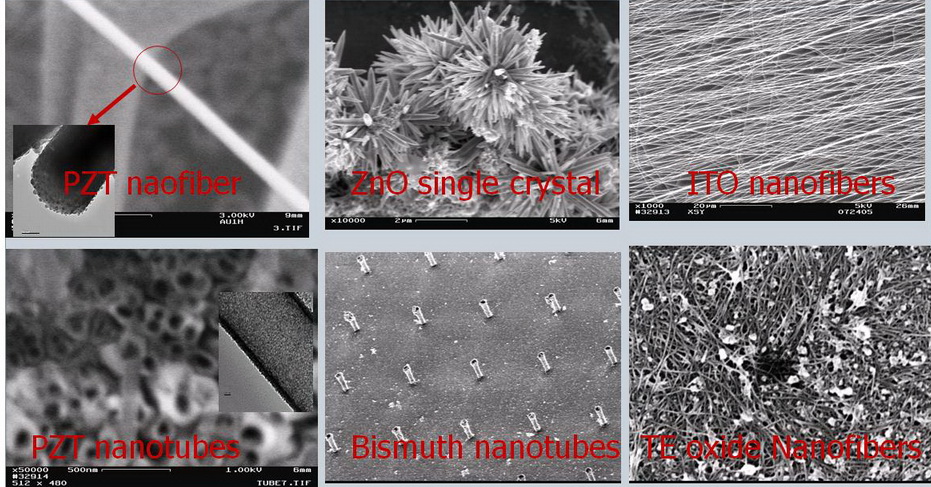|
Current research projects:
Nano AFC Acoustic Emission Sensors
The objective of the research is to to apply innovative nanotechnologies for creating acoustic emission (AE) sensors for real-time monitoring of structures. The proposed AE sensors are composed of Nanoscale Active Fiber Composites (NAFCs) and the project involves the design, manufacturing and characterization of the consisting of piezoelectric (PZT) nanofibers. This work will result in advanced self-powered sensors with high sensitivity, excellent conformability and suitability for being imbedded into or attached on the surface of structures.(Shiyou Xu, NSF funding,CMMI #0826418)
Fabrication and characterization of active nanomaterials and nanostructures
- Piezoelectric nanostructures
- Conductive nanostructures
- Thermoelectric active nanostructures
- Photovoltaic nanostructures
Ultra Sensitive Nano Gas and Bio Sensors
Nano sensors have a lot of applications in firefighting, biomedical, chemical, drug and food industries. The objectives of this project are to develop highly sensitive and selective nano gas sensor and determine their sensitivity to specific gases like alcohol vapor and NO2 to further improve its performance.Currentlly gas sensors in our lab is based on ITO nanofibers, the resistance of the ITO nanofibers will increase sharplly when under the objective gases. A parallel project is to develop nano sensor array for the detection of finger-print bio molecules for early stage stroke diagnostics.(Shiyou Xu, and Xi Chen)
MEMS/NEMS Device for Energy Harvesting
The miniaturized wireless devices and networks have led to the need for efficient self power generation since battery replacements would be highly unfeasible for some applications. Vibration, thermal and radiation energy scavenging using nano and micro scale piezoelectric, pyroelectric and photovoltaic materials will be explored. The objective is to design, fabricate micro and nano scale energy scavenging device which can be used as an on-chip power source for various MEMS scale devices. The figure shows the voltage generated from PZT nanofibers.( Weihe Xu, Xi Chen,and Shiyou Xu, and Natalie Schloeder, US Army funding )
Ultrasonic Diagnose System
The object of this project is to distinguish cancer cell from normal cell by using high frequency (up to GHz) ultrasound. Current cancer diagnostic involves expensive equipments which are not accessible to every people. The idea comes up with the fact that molecules and function groups usually have unique frequency because of the vibration of chemical bonding. By monitor their absorption and attenuation to certain frequency ultrasound, we can distinguished cancer cell from normal cells. These research will lead to a hyperspectural ultrasound transducer, and a 5D Medical imaging system.(Guitao Zhang, US Army funding)
|
Dye Sensitized Solar cells
Dye sensitized solar cells (DSSCs) are promising photovoltaic devices as they offer advantages such as low cost and simple fabrication process while having potentially high energy conversion efficiency compared with silicon based solar cells. The key component of a typical DSSC is a sintered film of TiO2 nanoparticles which has a large surface area for the absorption of dyes. However, the electron transport in TiO2 nanoparticles in a DSSC rely on trap-limited diffusion process, in which photo-generated electrons repeatedly interact with a distribution of traps before they can reach the collecting electrode. It has been shown that this trap-limited process leads to a higher probability of charge¨Ccarrier recombination, which diminishes the device efficiency. In this project, we are exploring one dimensional nanostructure such as TiO2 nanofibers to improve electron transport and enhance efficiency of solar cells. Currently an open circuit voltage of 0.7 V and a short circuit current density of 1 mA /cm2 have been demonstrated. (Jinwei Li, and Shiyou Xu)
Propulsion and Power subsystem for the Micro Biosystem
One of the maijor difficulty in developping microscale under water robot is the driveing system. In this project, a biomimetic propulsion mechanism which provides the maneuverability of the device at low Reynolds¡¯s number will be developed. We use undulated motion which is similar to the motion of a sperm cell as a driving mechanism. Along with the help of novel piezo nanomaterials, this driving system may become true in the near furture. The system can be used in micro medical robot designed for drug delivery or other medical problems.(Guitao Zhang)
Virtual lab for MEMS system
In order to well under standing MEMS system and learn the courses, Students need to do experimentd such as spin coating, Photolithography, etching, etc. These experiment are either too expensive to be carried out or dangerous to be operate. Virtual lab for MEMS system can help student do these experiment preliminarily in one's own computer to prepare for the real experiment. Also this system can also help to design some MEMS devices, people can change the parameters interactively in the soft ware to achieve the effect they want.(Guitao Zhang)
MEMS Umbrella-shaped Actuator with Active Structure for Medical Applications
The objective of this research is to design, fabricate and test an umbrella-shaped microactuator for thrombus retrieval in stroke therapy.The functional principle of the actuator is unique in that it can provide a dynamic shear force on blood clots in vascular arteries. This shear force can be fine-tuned to facilitate the separation of the blood clot from the wall of the vascular artery due to the shearing-thinning phenomenon, thus enabling complete retrieval while minimizing the risk of damage to the arteries. This research will contribute new fundamental knowledge in the areas of piezoelectric response of nanomaterials as well as the mechanical behavior of blood clots.Stroke is the third leading cause of death in the U.S, with blockage of arterial blood flow accounting for 83% of all strokes. This research will lead to a safe and reliable stroke therapy providing recanalization of blocked vascular arteries on the order of minutes.(Xi Chen, Sobi LI, and Swathi Vallala,NSF funding,ECCS #0821606)
Thermoelectric nanostructures for thermal energy scavenging
Perovskite La1-xSrxCoO3 is a very promising complex oxide thermoelectric material. It is expected that its thermoelectric figure of merit ZT will be significantly increased at nanoscale. We are developing cobalt-based nanostructures to convert thermal energy to electricity using integrated micro and nanofabrication methods. This project involves the fabrication of thermoelectric nanofibers; design and fabrication a MEMS scale tester for the measurements of the Seeback coefficient and characterization of thermal/electric properties, and the optimization of the performance of energy harvesting device, which can potentially be used as portable wireless energy source as well as large scale energy converter. (Weihe Xu, Regina Pynn, and Dante Smiriglio)
|






